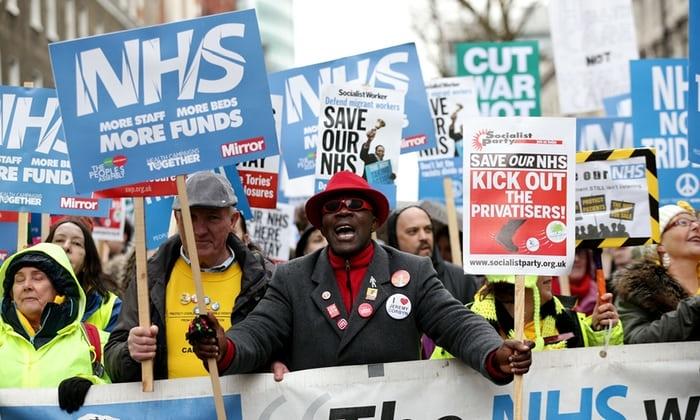As People In UK Rally For The National Health Service, India Ought To Pay Attention

In January, thousands of people in London marched to protest against the underfunding of the National Health Service (NHS) — the publicly funded and universal healthcare system of the United Kingdom (UK) — which reached a crisis situation in this winter.
Not only is the NHS free at the point of delivery to anyone who needs it, it is also the best healthcare system in the developed world.
It is the world’s largest single-payer healthcare system (where a single public authority pays for the essential healthcare of all residents; financed by taxes).
And yet the UK spends among the smallest proportion of its GDP on health among the developed nations (around 9.9%).
On the other hand, the United States (US) spends among the highest proportion of its GDP (16.6%), and yet has the worst health system in the first world, not having universal access to healthcare but only coverage (meaning insurance that only fills private coffers) while leaving around 44 million Americans uninsured.
However, years of mounting austerity measures have taken a toll on the NHS. On 10 January, 68 specialists in emergency medicine from hospitals across England and Wales wrote a letter to Prime Minister Theresa May, highlighting the extent of the crisis facing the “severely and chronically underfunded” NHS.
After the 3 January protest march, US President Donald Trump took it as an opportunity to decry the demands in his own country for a publicly funded and universal healthcare system.
Trump tweeted, “The Democrats are pushing for Universal HealthCare while thousands of people are marching in the UK because their U system is going broke and not working. Dems want to greatly raise taxes for really bad and non-personal medical care. No thanks!”
His misguided comments were widely condemned in the UK, including by Theresa May (through her spokesperson), health secretary Jeremy Hunt as well as by Labour leader Jeremy Corbyn.
We take a quick look at what is plaguing the NHS — the world’s best and most affordable healthcare system.
The NHS was founded in 1948 by the Labour government, following World War II.
The NHS consists of four public health services in the UK — NHS England, NHS Scotland, NHS Wales, and Health and Social Care in Northern Ireland.
“It was the first health system in any Western society to offer free medical care to the entire population,” writes Rudolf Klein in The New Politics of the NHS: From Creation to Reinvention (1983).
“It was, furthermore, the first comprehensive system to be based not on the insurance principle, with entitlement following contributions, but on the national provision of services available to everyone. It thus offered free and universal entitlement to State-provided medical care. At the time of its creation it was a unique example of the collectivist provision of health care in a market society.”
Klein goes on to note: “Indeed, it could be held up as 'the greatest Socialist achievement of the Labour Government', to quote Michael Foot, the biographer of Aneurin Bevan who, as Minister of Health in that Government, was the architect of the NHS… From then on, everyone was entitled, as of right, to free care – whether provided by a general practitioner or by a hospital doctor – financed by the State.”
The attack on the NHS began in the 1980s, as the Margaret Thatcher government unleashed the neoliberal agenda.
“As public health doctor and scholar Allyson Pollock describes in NHS Plc: The Privatisation of our Health Care, Thatcher’s government imposed intermittent austerity funding and the incremental imposition of market-based reforms such as the “internal market” and the “private finance initiative,” signaling a retreat from the NHS’s initial collectivist provisions and a partial move toward commodification,” to writes Adam Gaffney in Jacobin.
Eventually, the Labour government of Tony Blair increased the expenditure by around 7% each year, which continued between 2000/01 and 2010/11, while the average increase over the lifetime of the NHS was 4%.
In 2010, David Cameron’s Conservative-led government destabilized the NHS by reorganizing the service by passing the 2012 Health and Social Care Act and by instituting a period of funding austerity the likes of which the NHS had never seen.
As for the 2012 law, “health policy scholar John Lister described the law in a phone interview as a “massive top-down reorganization of the NHS” that pushes it further onto the free market, effectively displacing (some) care provision into the private sector,” to quote Gaffney again.
“And as Pollock and lawyer Peter Roderick — both supporters and advocates for a fully public NHS — wrote in the British Medical Journal last year, the law calls for a number of “reductions and restrictions [of health care that] pave the way for mixed funding arrangements and a gradual shift to private insurance and charges to patients,” the article goes on.
Between 2010-11 and 2016-17, health spending increased by an average of 1.2% above inflation, as the Guardian says. This is below the yearly inflation-proof growth rate of the NHS of nearly 4% before 2010, stretching back to the 1950s.
Currently, the planned spending for the Department of Health in England for 2017-18 is approximately £124.7 billion, including the £335 million bailout announced in the 2017 Autumn Budget.
An extra £1.6 billion from April was also announced to cover the 2018-19 year, however, as this Guardian breakdown of the financial troubles of the NHS, “analysts believe it amounts to about half of what the service requires to keep up with demand.”
“According to the health policy thinktank the King’s Fund, the money only makes up for higher than expected inflation and keeps the real-terms increase for the next three years at 1.2%, which “is not sufficient to cover growing demand,” the Guardian says.
The Department of Health budget is expected to by grow by 1.2% in real terms between 2009-10 and 2020-21.
As the UK continues to fight for the NHS, the government in India is making false promises about “steadily but surely progressing towards a goal of universal health coverage” in the form of insurance which has been proven to be ineffective, exclusionary and only enriching the profiteering private medical establishment — and nowhere near universal.
For perspective, consider that despite the NHS currently being cash-strapped and understaffed, no one in the UK goes bankrupt in order to pay medical bills — unlike in India, where 50.6 million people were pushed below the poverty line due to out-of-pocket spending on healthcare between 2004 and 2014.
Get the latest reports & analysis with people's perspective on Protests, movements & deep analytical videos, discussions of the current affairs in your Telegram app. Subscribe to NewsClick's Telegram channel & get Real-Time updates on stories, as they get published on our website.
























